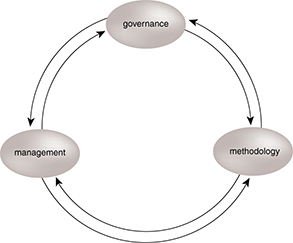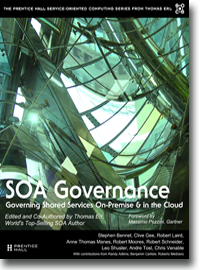SOA Patterns > Basics > SOA Governance > Governance 101 > The Scope of Governance
The Scope of Governance
Within IT, a governance system is responsible for providing organization, direction, and guidance for the creation and evolution of IT assets and resources. To fully understand the scope of a governance system within a given IT community, we need to determine how a governance system relates to and is distinguished from methodology and management (Figure 1).

Figure 1 – Governance, management, and methodology are distinct areas within an IT department that also share distinct relationships.
Governance and Methodology
Methodology represents a system of methods. Within IT, the form of methodology we are generally concerned with is that used to create software programs and business automation solutions. In this context, the methodology determines a system of methods used to conceptualize, design, program, test, and deploy a software program. These methods are generally formalized as a series of step-by-step processes that correspond to project delivery lifecycle stages.
NOTE
In this book, it is implied that a methodology refers to a project delivery methodology or software development methodology (also known as a “software development process”).
Different software delivery methodologies exist. What commonly distinguishes one from the other is how they prioritize tactical and strategic requirements in relation to overarching business goals. These priorities will usually result in different processes (project lifecycle stages) being combined or organized in different ways. In some cases, one methodology may introduce a new process that does not exist in other methodologies – or – it may exclude a process that commonly exists in other methodologies. Frequently, however, it comes down to how much time and effort a given process or project lifecycle stage receives as determined by the tactical and strategic priorities of the methodology.
How a methodology is defined and carried out is heavily influenced by the governance system. Essentially, the methodology must be determined so that it follows the constraints established by the governance system and the corresponding methods (processes) must be carried out in compliance with these constraints, as well as any additional constraints that may be further introduced by the methodology itself.
Governance and Management
Whereas a governance system establishes rules and constraints, it is not responsible for enforcing them or overseeing related activities to ensure compliance. Management refers to the system and resources responsible for day-to-day operations.
Within an IT environment, this basically pertains to the execution of activities. In relation to governance, a management system provides the hands-on means by which the constraints and goals of the governance system are realized in the real world. Therefore, the management of a governance system represents a subset of the overall management responsibilities.
Management systems are assigned to and carried out by those with authority.
Methodology and Management
Management relates to methodology the same way it relates to governance. When building software programs according to a pre-defined methodology, a management system is used to ensure the proper execution of processes and project delivery lifecycle stages in compliance with the constraints of the methodology – and – the constraints of the governance system.
Comparisons
The following list contains a series of sample distinctions to further help provide a clear separation between governance, methodology, and management:
- Governance establishes rules that control decision-making.
- Methodology establishes processes that comply to governance rules and may introduce additional rules.
- Management makes decisions according to governance rules.
- Governance does not dictate when or how to make a decision. It determines who should make the decision and establishes limits for that person or group.
- Methodology establishes processes that carry out specific types of decision logic that adhere to governance rules.
- Management is responsible for day-to-day operations and for ensuring that decisions made adhere to governance and methodology rules.
- Governance cannot replace management or methodology, nor can it compensate for poor management or poor (or inappropriate) methodology.
- Poorly defined and executed methodology can jeopardize the business goals associated with governance.
- Poor management can undermine a governance system and a methodology and will jeopardize associated business goals.
- Neither management nor methodology can replace governance, nor compensate for poor governance.
- A poor governance system inevitably inhibits the ability of a methodology to fulfill business automation requirement potential.
- A poor governance system inevitably inhibits the ability of management to make correct decisions.
As previously stated, while this book will make many references to management and methodology, it is primarily focused on governance.

